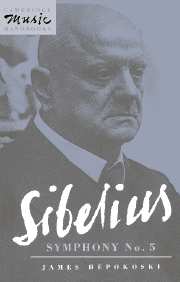Book contents
- Frontmatter
- Contents
- Preface
- 1 Introduction: Sibelius and the problem of ‘modernism’
- 2 The crisis, 1909–14: ‘Let's let the world go its own way’
- 3 Reassessed compositional principles, 1912–15: the five central concepts
- 4 Of Heaven's door and migrating swans: composing a confession of faith
- 5 Musical process and architecture: a proposed overview
- 6 Editions and performance tempos: a brief note
- Notes
- Select bibliography
- Index
- Mahler: Symphony No. 3
3 - Reassessed compositional principles, 1912–15: the five central concepts
Published online by Cambridge University Press: 11 January 2010
- Frontmatter
- Contents
- Preface
- 1 Introduction: Sibelius and the problem of ‘modernism’
- 2 The crisis, 1909–14: ‘Let's let the world go its own way’
- 3 Reassessed compositional principles, 1912–15: the five central concepts
- 4 Of Heaven's door and migrating swans: composing a confession of faith
- 5 Musical process and architecture: a proposed overview
- 6 Editions and performance tempos: a brief note
- Notes
- Select bibliography
- Index
- Mahler: Symphony No. 3
Summary
Peaking in 1912 after the discouraging continental reception of his Fourth Symphony, Sibelius's Modernist/New Music crisis encompasses both compositional and sociological issues. The ‘emancipation of the dissonance’, for instance, was not merely an up-to-date harmonic preference. More fundamentally, it was a high-profile surface component of a growing artistic and culture-critical wave that was challenging the musical institutions of European liberal-bourgeois culture that the earlier modernists (the ‘Generation of the 1860s’) had been committed to nourishing. With its multiplicity of individualized accents, the triadically based, post-Wagnerian musical language of the 1889–1914 period was far from a culturally neutral system to be approached only in technical terms; rather, it was a sign of the institution of art music with which it was inextricably linked. Put another way, a key feature of symphonic modernism's musical language was that it thematized not only its ostensible ‘content’ (Till Eulenspiegels, fauns, Tuonelan swans, transfigurations and resurrections, seascapes, landscapes, and so on) but also the sociopolitical currents in which it thrived. When composers continued to reflect on (and with) that language in imperiled times, they were simultaneously affirming the continued validity of the cultural principles that had stirred those currents in the first place. This generational or cultural clash lay at the heart of the Modernist/New Music crisis that was spreading throughout prewar Europe.
- Type
- Chapter
- Information
- Sibelius: Symphony No. 5 , pp. 19 - 30Publisher: Cambridge University PressPrint publication year: 1993



